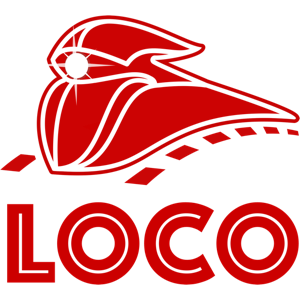Loco-JS-UI connects Loco-JS-Model with UI elements on a page
🧐 What is Loco-JS-UI?
Loco-JS-UI is an optional part of the Loco framework. It can be used along with Loco-JS to connect models with UI elements like forms. Models are created using Loco-JS-Model and they connect JavaScript objects with their representation on the back-end.
Loco-JS-UI supports only a <form> element throughout all HTML elements at this moment.
Visualization of the Loco framework:
Loco Framework
|
|--- Loco-Rails (back-end part)
| |
| |--- Loco-Rails-Core (logical structure for JS / can be used separately with Loco-JS-Core)
|
|--- Loco-JS (front-end part)
|
|--- Loco-JS-Core (logical structure for JS / can be used separately)
|
|--- Loco-JS-Model (model part / can be used separately)
|
|--- other built-in parts of Loco-JS
Loco-JS-UI - connects models with UI elements (a separate library)
📝 UI.Form
UI.Form is a class that connects a model instance with a form. It allows users to modify model attributes.
UI.Form converts attributes of the model's instance to values of the corresponding form elements.
It delivers a front-end validation without an extra effort, and it turns a standard static form into a dynamic, submitted asynchronously one.
Example:
import { UI } from "loco-js-ui";
import CommentModel from "models/article/Comment";
// ...
const active = () => {
console.log("The comment is being updated...");
}
const failure = () => {
console.log("Update failed or front-end validation hasn't passed.");
}
const updated = data => {
document.querySelector("form").style.display = "none";
renderFlash({ notice: data.notice });
};
export default (opts = {}) => {
const form = new UI.Form({
for: new CommentModel({ id: opts.commentId, resource: "admin" }),
// (optional) a model instance connected with the form
id: `edit_comment_${opts.commentId}`,
// (optional) the ID attribute of the HTML <form> element.
// If not passed - it is resolved based on the value of a model's ID property to:
// * if present => `edit_${lowercased model's identity property}_${model's ID}`
// * if null => `new_${lowercased model's identity property}`
initObj: true, // (optional) determines whether to initialize the passed object based
// on values of the corresponding form elements.
// False by default (object retains the initial attribute values)
callbackActive: active, // (optional) function called after sending the request
callbackFailure: failure // (optional) function called if an object is invalid
// on the front-end or back-end side (400 HTTP status code)
callbackSuccess: updated // (optional) function called on success
});
form.render();
};From the HTML perspective - the following example shows how a form should be structured. What you should pay attention to is that all tags related to a given attribute should be wrapped in a tag with a proper data-attr attribute. The value of this attribute should match the remote name of the given attribute (the name of the corresponding attribute on the server-side, returned by an API). This value is configurable in the model.
Look at how errors are expressed. The tag is irrelevant. Only errors class and data-for HTML attribute are essential.
<form id="edit_comment_1"
action="https://example.com/admin/articles/1/comments/1"
accept-charset="UTF-8"
method="post">
<p data-attr="author">
<label for="comment_author">Author</label> <br>
<input type="text" value="Tom" name="comment[author]" id="comment_author" />
<span class="errors" data-for="author"></span>
</p>
<p data-attr="text">
<label for="comment_text">Text</label> <br>
<textarea name="comment[text]" id="comment_text">Interesting article.</textarea>
<span class="errors" data-for="text"></span>
</p>
<div data-attr="article_id">
<input type="hidden" value="1" name="comment[article_id]" id="comment_article_id" />
</div>
<div data-attr="pinned">
<input name="comment[pinned]" type="hidden" value="0" />
<input type="checkbox" value="1" name="comment[pinned]" id="comment_pinned" />
<label for="comment_pinned">Pinned</label>
</div>
<div data-attr="admin_rate">
<label for="comment_admin_rate">Rate</label>
<select name="comment[admin_rate]" id="comment_admin_rate">
<option value="1">Awful</option>
<option value="2">Bad</option>
<option selected="selected" value="3">Decent</option>
<option value="4">Good</option>
<option value="5">Amazing</option>
</select>
</div>
<div data-attr="emotion">
<input type="radio" value="-1" name="comment[emotion]" id="comment_emotion_-1" />
<label for="comment_emotion_-1">Negative</label>
<input type="radio" value="0" checked="checked" name="comment[emotion]" id="comment_emotion_0" />
<label for="comment_emotion_0">Neutral</label>
<input type="radio" value="1" name="comment[emotion]" id="comment_emotion_1" />
<label for="comment_emotion_1">Positive</label>
</div>
<p>
<input type="submit" name="commit" value="Update Comment" />
</p>
</form>Keep in mind that a form submission sends all model attributes to the server. Sent attributes are not limited to only these available for modification via form fields. A value of a model's attribute can be an object as well. For example, if you want to send nested resources.
A model's instance is considered as new, not persisted on the server if the value of the ID attribute is null. Loco-JS will send the following XHR request upon form submission in this case.
Started POST "/admin/articles/1/comments"
Parameters: {"comment":{"author":"Tommy","text":"Interesting article.","article_id":1,"created_at":null,"updated_at":null,"emotion":0,"pinned":false,"admin_rate":3,"approved":null}}On the other hand, if the value of the model's instance ID attribute is not null, Loco-JS-UI sends the following XHR request to the server.
Started PUT "/admin/articles/1/comments/1"
Parameters: {"comment":{"author":"Tommy","text":"Interesting article.","article_id":1,"created_at":null,"updated_at":null,"emotion":0,"pinned":false,"admin_rate":3,"approved":null}}The success response from the server must be in the JSON format with the following structure:
{
"success": true,
"status": 200,
"data": { // (optional) this object is passed to
"id": 123, // callbackSuccess if defined
"notice": "foo bar baz"
},
"flash": { // (optional) UI.Form changes the value
"success": "Comment has been updated!" // of a submit button to this on success
},
"access_token": "123qweasd" // (optional) it is possible to send a signal from the server
// assigned to the returned access_token
}The example of the failure response:
{
"success": false,
"status": 400,
"errors": {
"text": ["is vulgar"],
"base": ["something is wrong with the whole object"]
}
}📥 Installation
$ npm install --save loco-js-ui⚙️ Configuration
Loco-JS-UI is usable only along with Loco-JS.
The following code shows how to connect both libraries.
import { connector } from "loco-js";
import { connect } from "loco-js-ui";
connect(connector);🤝 Dependencies
👩🏽🔬 Tests
npm run test📈 Changelog
Major releases 🎙
6.0 (2022-02-03)
- the implementation of the
connectfunction has been changed - Loco-JS-UI works with Loco-JS v6
📜 License
Loco-JS-UI is released under the MIT License.
👨🏭 Author
Zbigniew Humeniuk from Art of Code
